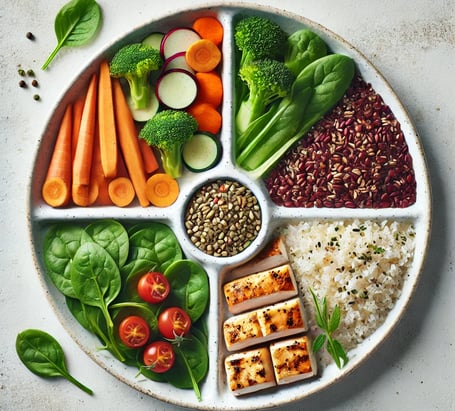
Master Portion Control: How to Effectively Understand & Apply It
After setting up your tools, focus on nutrition by mastering portion control. This criti-cal skill helps ensure balanced meals and supports your health goals.
MEAL PREP BASICS
Mae Ellison
2/17/20254 min read


How Do You Understand and Apply Portion Control?
Portion control is one of the most essential yet often overlooked elements of a balanced diet. Many people struggle to determine how much food is the right amount for their bodies, which can lead to overeating, weight gain, and poor nutritional balance. But portion control isn’t just about reducing food intake—it's about knowing the right amounts of each food group your body needs to feel satisfied, energized, and healthy. This article will break down the importance of portion control and provide you with practical tips for applying it to your everyday life.
What is Portion Control?
Portion control refers to the practice of managing the amount of food you eat, not by restricting yourself, but by understanding how much your body needs. It’s about learning the right portions for your meals, which can help maintain a healthy weight, support digestion, and prevent overeating.
One of the biggest challenges people face with portion control is the disconnect between what a serving size is (as defined by nutrition labels or health guidelines) and how much people actually eat. For example, a serving of pasta may be recommended as 1 cup, but in many restaurants or at home, portions can be several times that size. By understanding the difference between serving sizes and your own portion sizes, you can make smarter decisions about your food intake.
Why is Portion Control Important?
Portion control offers a wide range of health benefits, including:
Weight management: By keeping your portions in check, you avoid overeating, which helps with weight loss or maintaining a healthy weight.
Balanced nutrition: Eating the right portions ensures you’re getting a balanced mix of nutrients—proteins, carbohydrates, fats, vitamins, and minerals—without overconsuming any one group.
Improved digestion: Smaller, balanced meals are easier on your digestive system, helping it function more efficiently and prevent discomfort like bloating.
Ultimately, portion control is about finding the right balance. It allows you to enjoy a variety of foods, provides nourishment, and prevents excess intake that could harm your long-term health.
How Do You Apply Portion Control to Your Meals?
1. Recognize Serving Sizes vs. Portions
The first step in mastering portion control is understanding the difference between serving sizes and portions. Nutrition labels or food guides often provide recommended serving sizes, but the amount you eat (your portion) is up to you. For instance, a serving of rice might be listed as 1/2 cup, but you may find yourself serving a full plate. By recognizing what constitutes a standard serving, you can be more mindful of how much you're eating.
2. Use Simple Visual Cues
When you’re not measuring food with cups or a scale, use your hands as a guide. Visual cues can be a quick and effective way to control portions:
Protein: A portion of protein (like chicken or fish) should be about the size of your palm.
Carbs: A serving of grains, such as rice or pasta, should fit into your cupped hand or about half the size of your plate.
Vegetables: Aim to fill half of your plate with vegetables, which will naturally be lower in calories and provide high amounts of vitamins and fiber.
3. Use Smaller Plates and Bowls
One simple trick to help control portions is to use smaller plates and bowls. Studies have shown that people tend to eat more when given larger plates, simply because they fill the plate up. By using smaller dishes, you can create the illusion of a fuller plate, while still eating a reasonable amount of food.
4. Eat Slowly and Mindfully
Mindful eating is an effective strategy for portion control. When you eat slowly, you give your brain the time it needs to send signals to your stomach that you are full. Pay attention to how your food looks, tastes, and smells, and focus on enjoying each bite. This approach helps you avoid overeating and allows you to stop eating when you’re comfortably full, not stuffed.
5. Pre-Portion Your Snacks
It’s easy to overeat when snacking, especially with packaged foods that offer no built-in portion control. Rather than eating straight from the bag, try pre-portioning your snacks into smaller containers or bags. This will help you limit your intake and reduce mindless snacking.
6. Be Aware of Restaurant Portions
When dining out, restaurant portions are often much larger than what you would normally eat at home. You can take steps to control your portions by asking for a smaller portion, sharing your meal, or asking for a to-go box right away and saving half for later.
How Portion Control Supports a Healthy Eating Pattern
Applying portion control isn’t about dieting or cutting out foods. Instead, it’s about ensuring that your meals are balanced, with the right amounts of protein, carbohydrates, fats, and vegetables. By keeping portions in check, you’re able to enjoy a wide variety of foods without overindulging.
Here’s how portion control fits into a healthy eating pattern:
Balanced meals: By filling half your plate with vegetables, one-quarter with lean proteins, and one-quarter with whole grains or healthy carbs, you create a balanced, nutrient-dense meal.
Satisfaction without excess: Portion control ensures you’re eating enough to feel full and satisfied without eating beyond your body’s needs.
Sustainable eating habits: Portion control is a sustainable practice that you can incorporate into every meal, whether at home, at a restaurant, or at a social gathering.
Practical Tips for Successful Portion Control
1. Control Your Portions at Home
When preparing meals at home, make sure to follow portion guidelines and avoid cooking large amounts of food that encourage overeating. Try serving food directly onto plates instead of placing serving bowls on the table, which makes it easier to overeat.
2. Focus on Quality, Not Just Quantity
While portion control helps you eat the right amounts, it’s equally important to focus on the quality of your food. Choose nutrient-dense options like vegetables, lean proteins, and whole grains over processed or high-calorie foods. A balanced plate will not only control calories but will also provide essential nutrients that your body needs.
Final Thoughts on Portion Control
Mastering portion control is an essential skill that will support your long-term health goals, whether you're managing your weight, improving digestion, or striving for a more balanced diet. The key is to be mindful of the amount of food you’re eating, use simple visual cues, and enjoy your meals at a pace that allows your body to recognize fullness.
By following these tips and adjusting your eating habits, you’ll develop a healthier relationship with food—one where you can enjoy what you eat without overindulging. Start with small changes, and over time, portion control will become a natural part of your eating routine.
